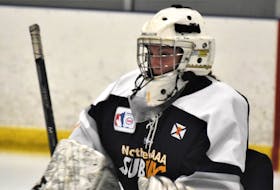The rain forecast for this week has made me anxious to head out after sea run trout which should be making their return from the sea anytime now. I am hoping the rain will raise water levels in our rivers. This is often the signal trout are waiting for to return to their home rivers. On Cape Breton the term sea trout is used interchangeably for brook, brown and rainbow trout which spend part of their life cycle in the sea. The term used by biologists for fish which spend part of their life cycle in the sea, returning to spawn in freshwater to spawn, is anadromous or diadromous.
Sea run brook, or speckled trout, are especially prized among anglers. These sea run brook trout usually run into fresh water in distinct runs, often triggered by a rise in water levels. Historically this run of sea trout has coincided with the appearance of wild strawberries- hence the anxiously awaited strawberry run. Other anglers refer to it as the lilac run since blooming lilacs also appear around the same time as the trout. While sea trout runs are found in many coastal rivers of Cape Breton, not all trout go to sea. Many live out their life strictly in freshwater. The factors which trigger trout to decide to move to the sea are often related to habitat and food. Trout may leave the hot, low water which is found in many of our rivers to take advantage of the cooler waters of the bay. The ocean also provides a good food source for these trout and as a result they are able to reach sizes seldom seen in our freshwater lakes and streams. While in the sea it is believed most brook trout stay fairly close to their home rivers and dont stray too far. Much of the early scientific work on sea run brook trout was carried out in Nova Scotia in the 1930's. Researchers working on the Moser River, on the eastern shore investigated when trout ran in the river, what they ate and so on. They found that the majority of sea run brook trout returned to the river in July, with the run following a rise in water.
In my experience when sea trout first enter the freshwater they arent usually that fussy. They will eagerly hit most bait, lures or flies. However once they have been in freshwater for a week or so they become more like resident trout and are harder to fool. My favourite sea trout streamer is a modification of the muddler minnow that I call the smelt muddler. The silver body does a good job of imitating most minnows and bait fish.
Hook: Streamer No. 6-10
Tail: Red Yarn
Body: Silver Tinsel
Wing: Gray squirrel topped with mallard flank and several strands of peacock herl
Head: Deer or caribou hair spun on and trimmed
Tip Of The Week
Anglers fishing sea run brook trout on Middle and Baddeck Rivers, as well as Lake OLaw Brook should be aware of the special regulations in place on these systems.
Cape Breton native Don MacLean is a fisheries biologist and a resident of Pictou. He writes on sportfishing for a variety of publications.
Trout from the sea
None
STORY CONTINUES BELOW THESE SALTWIRE VIDEOS
Two youths charged with second degree murder | SaltWire #newsupdate #halifax #police #newstoday








